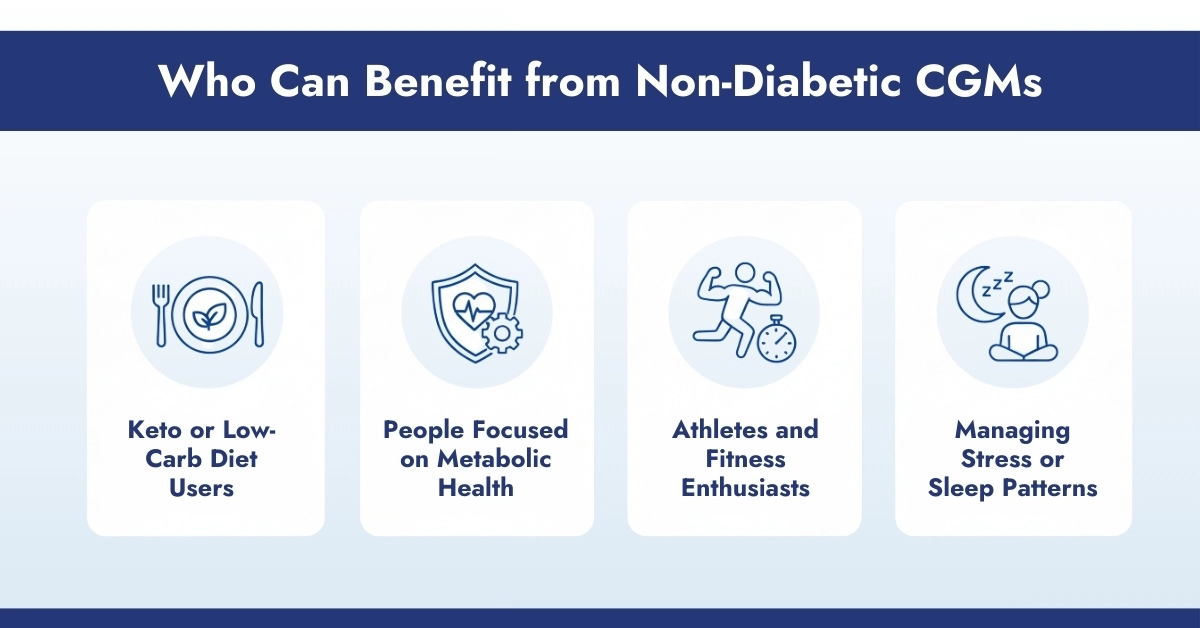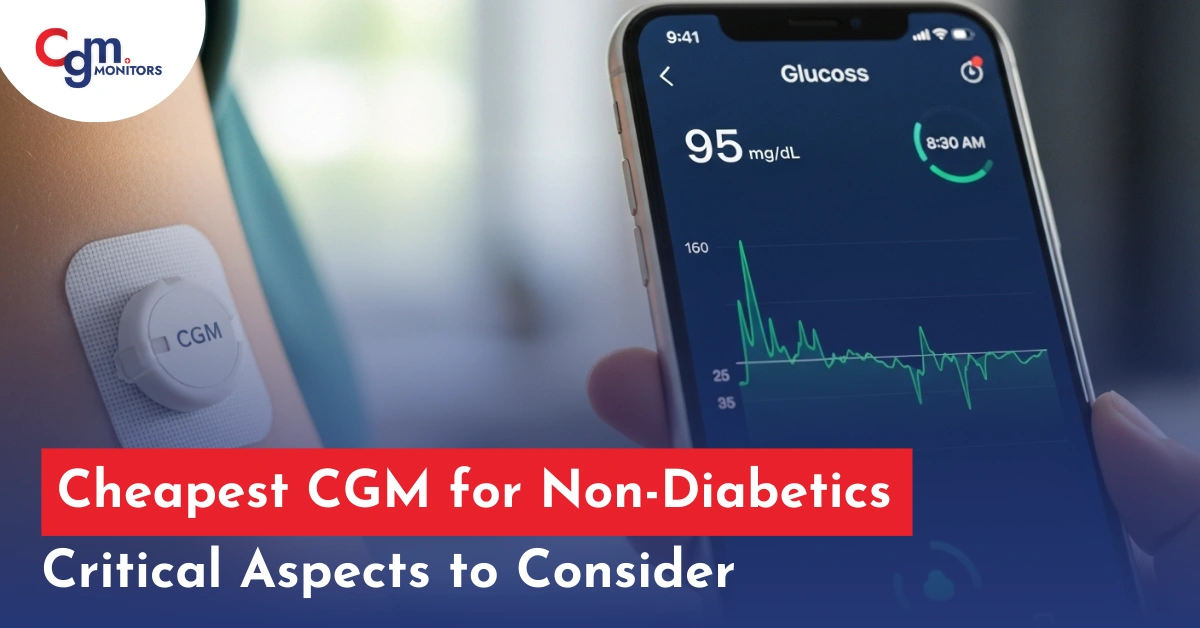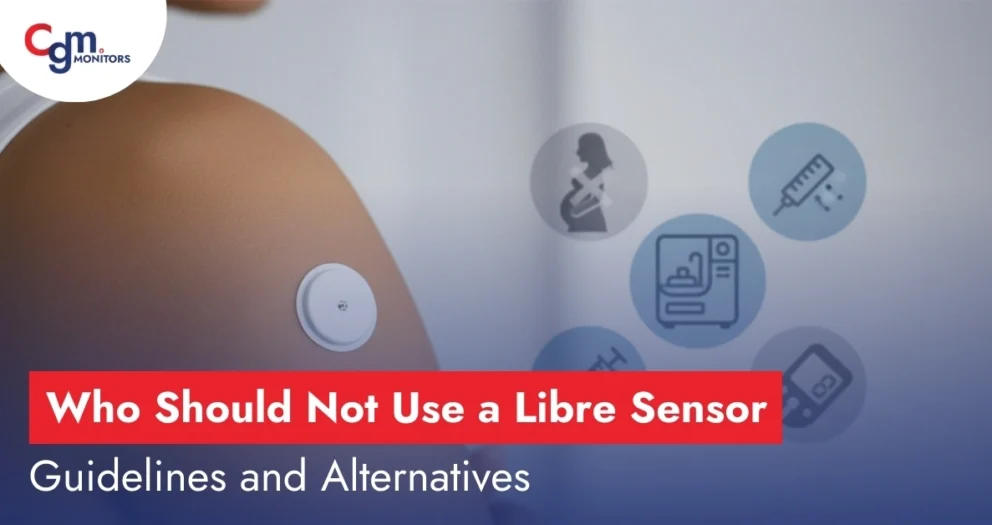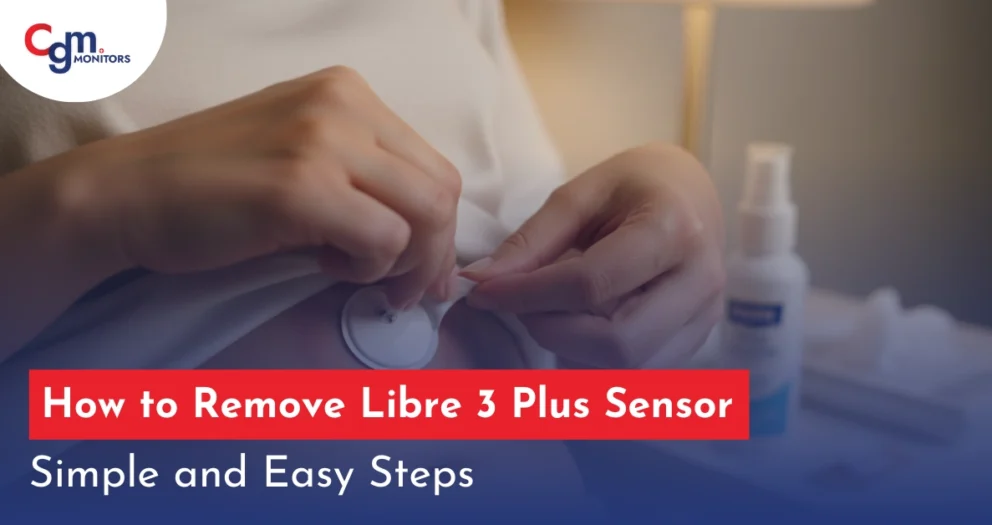Table of content
- Biosensor for Non Diabetics/CGM without prescription
- Biosensors & Their Need for Non-Diabetics
- Endocrinologists Weigh In: Should Non-Diabetics Use a CGM?
- Non-Diabetic CGMs vs. Diabetic CGMs:
- Why Are Biosensors Cheaper Than Traditional CGMs?
- Who Can Benefit from Non-Diabetic CGMs?
- Is It Safe for Non-Diabetics to Use a CGM?
- Best CGM for Non diabetics: Affordable Option
- Extra Tips for Finding the Cheapest CGM for Non-Diabetics
- Conclusion:
- Frequently Asked Questions
Are you a non-diabetic individual looking to track your glucose levels without a prescription? A continuous glucose monitor (CGM) is a great tool for measuring blood sugar levels without pricking finger, for people living with diabetes. When looking for the cheapest CGM for non-diabetics, search for them by the right name: biosensors.
All CGMs are biosensors, while not all biosensors are CGMs.
Biosensor for Non Diabetics/CGM without prescription
Some of the affordable CGMs without insurance for 24/7 finger-prick-free glucose monitoring. Both of these biosensors are eligible for purchase using your pre-tax HSA or FSA funds:
Important: Do NOT use these sensors if you are on insulin or experience hypoglycemic (low-sugar) events.
Stelo by Dexcom
- Current one-time purchase cost is $99.00. However, getting a 3 months subscription at $252 brings down the cost of each sensor to $84.00. This is FSA/HSA eligible.
- No prescription biosensor that lasts up to 15-day, has a 12-hour grace period, and can be used by anyone who is not on insulin, yet is concerned about health.
- Indicated for people aged 18 and above.
- Worn on the back of upper arm, this sensor detects your blood glucose.
- Stelo app is available on both Android and iOS. Plus, the data can be shared with your doctor as well.
- Waterproof and can be submerged in up to 8 feet water up to 24 hours.
- Great option for tracking glucose fluctuations smartly.
- Buy Dexcom Stelo Biosensor at an affordable price on CGM Monitors.
Lingo by Abbott
- Lingo is one of the cheapest CGMs for non diabetic, offering continuous glucose monitoring without insurance.
- A 2-week trial plan starts as low as $49.00. However, getting a 3 months (12-week) subscription at $249 brings down the cost of each sensor to $41.5.
- No prescription biosensor that lasts up to 14-day, and can be used by anyone who is not on insulin, yet is concerned about their health.
- Indicated for people aged 18 and above.
- Worn on the back of the upper arm, this sensor detects your blood glucose from your interstitial fluid.
- Currently supported only on iOS, the Lingo app can be connected to Apple Health.
- The Lingo sensors are water resistant, allowing you to take showers or get involved in workouts.
- Check it out on Lingo’s website.
Biosensors & Their Need for Non-Diabetics
- CGM sensors are small devices typically worn on the back of upper arm with the help of a micro pin that track glucose levels from interstitial fluid throughout the day – all without needing to prick your finger. While they’re mainly used by people with diabetes, CGM for non diabetics is becoming popular for those interested in blood sugar monitoring for non diabetics.
- These devices can help you understand how your body reacts to different foods, stress, and exercise. If you’re someone who wants to optimize their health or keep an eye on glucose fluctuations, a CGM could be useful.
- Affordable continuous glucose monitoring gives you peace of mind about your health, but remember, it’s not a must for everyone!
Looking to get a CGM sensor instead of a biosensor? Get a free benefits check now.
Endocrinologists Weigh In: Should Non-Diabetics Use a CGM?
- Most endocrinologists agree that while CGMs for non diabetics are safe to use, they’re not necessary unless you have specific concerns about your glucose levels.
- The main benefit? Continuous glucose monitoring for non diabetics can help track food-related blood sugar spikes, giving you insights into how your body works. But remember, it’s more of a wellness tool than a diagnostic one.
So, if you’re interested in tracking your blood sugar, it’s probably a good idea to chat with a healthcare professional first.
Non-Diabetic CGMs vs. Diabetic CGMs:
Here’s a quick comparison between CGMs for diabetics and CGMs for non-diabetics:
Diabetic CGMs:
- Designed for those who need to track insulin levels. Some of the CGMs, such as Dexcom G7 (18+ only) offer especial alerts for minimizing hypoglycemic conditions.
- Often used for multiple readings throughout the day to help with medication adjustments.
- These devices are more expensive due to their medical-grade functionality.
Non-Diabetic CGMs:
- Primarily for tracking overall wellness and glucose stability.
- Generally, you’ll check your glucose level after meals or during exercise.
- CGM device cost for non-diabetics is usually lower because these devices aren’t as specialized for medication management.
- Not for individuals who are on insulin or experience low glucose adverse events.
Price Difference: Non-diabetic devices tend to be more affordable, making them perfect for those looking to monitor their blood sugar on a budget.
Why Are Biosensors Cheaper Than Traditional CGMs?
Biosensors like Stelo and Lingo cost less than medical CGMs because they are the best glucose monitors for wellness and are designed for tracking, not diabetes management. Here’s why they’re more affordable.
- No Alarms or Alert System as we see in Libre 2 Plus or Dexcom G7.
- Not built for Hypoglycemia and hyperglycemia prevention compared to Libre 3 Plus.
- Less Strict FDA Requirements and easy to carry with no effort.
- No Insulin Decision Support as we see in Omnipod 5.
- Simpler Sensor Design with no complex features.
Who Can Benefit from Non-Diabetic CGMs?
We know that non-diabetic CGMs aren’t medical devices for diagnosis. They can be valuable for anyone interested in understanding their blood sugar patterns. Here are some examples of people who might find them useful:
- Keto or Low-Carb Diet Users: See how your meals impact blood sugar in real-time and adjust your macros for better energy and fat metabolism.
- People Focused on Weight Loss or Metabolic Health: Identify hidden spikes caused by certain foods or snacks, helping you make smarter dietary choices.
- Athletes and Fitness Enthusiasts: Track how your glucose levels respond to different workouts or recovery periods to optimize performance.
- Individuals Managing Stress or Sleep Patterns: Stress and poor sleep can affect glucose. Monitoring trends helps you understand how lifestyle factors influence your body.

Is It Safe for Non-Diabetics to Use a CGM?
- Not dangerous—but there are a few things to keep in mind. Most non-diabetic individuals can use a CGM for non diabetics without any issues, but don’t go overboard.
- Misinterpretation of data: Sometimes, non-diabetic CGMs can cause unnecessary stress over minor fluctuations in blood sugar.
- Skin irritation: A small percentage of people experience irritation from the adhesive. But this is rare, and switching to a hypoallergenic option can help.
Best CGM for Non diabetics: Affordable Option
If you had to pick one CGM that is the best continuous glucose monitor for non diabetics and has an affordable option, the Dexcom Stelo CGM is a winner among all. Want to hear from real people? According to a Reddit thread on CGMs for non-diabetics, many users are loving affordable options like Lingo and Stelo. Here’s what they’re saying: “Stelo and Lingo are being praised for their cheaper CGM without insurance costs. Users report being able to track their glucose levels throughout the day without the need for a prescription.”
A few Redditors shared that they’ve noticed better control over their glucose levels after meals, and they feel more in tune with their bodies. There are, however, mixed reviews on the wearable glucose monitor cost, but overall, non-diabetic users are finding the experience valuable.
Extra Tips for Finding the Cheapest CGM for Non-Diabetics
- Look for Promotions and Discount Codes: Many CGM brands like CGM Monitors offer discounted CGM deals during special sales or holidays – you may enjoy Freestyle Libre CGMs at competitive pricing and free delivery at your door (within USA).
- Insurance: While CGM for non diabetics isn’t typically covered by insurance, some plans may provide partial coverage. It’s worth checking with your provider.
- Price Comparison: Be sure to compare prices across different platforms before purchasing. Some stores may offer cgm without insurance at a better price than others.
Conclusion:
It’s always a better idea to consult your healthcare specialist before you take any medical action. It’s important to note that the no-prescription bio-sensors are not intended for making any diagnosis. If you consume insulin or experience low sugar adverse events, Do NOT use the biosensors.
Disclaimer: For more information on affordable CGM without insurance, feel free to visit CGM Monitors. Stay informed, and track your glucose levels the right way!
Frequently Asked Questions
What is a CGM and how does it benefit non-diabetics?
A Continuous Glucose Monitor (CGM) is a wearable sensor that tracks glucose levels in real-time from interstitial fluid under the skin. For non-diabetics, it reveals how food, exercise, stress, and sleep impact glucose levels, helping to optimize energy, focus, and metabolic health.
Can I get a CGM if I don't have diabetes?
Individuals without diabetes can now access OTC continuous glucose monitors (CGMs) designed for wellness tracking, such as Dexcom Stelo or Abbott Lingo, without a prescription. We do not recommend you to use these CGM Monitors like Dexcom G6,G7 and FreeStyle lIbre 2+ and Libre 3 Plus, if you do not have diabetes.
How do non-diabetics get access to a CGM device?
Non-diabetics can purchase over-the-counter CGMs like Dexcom Stelo or Abbott Lingo without a prescription. Alternatively, subscription programs (e.g., Nutrisense or Levels) provide sensors with app support and optional nutrition coaching.
Who can benefit most from using a CGM without having diabetes?
Those aiming to optimize performance, such as athletes tracking fuel needs or biohackers seeking steady energy. Individuals focused on weight loss, improved sleep, or preventive health through understanding metabolic responses benefit greatly.[/vc_toggle
Who should avoid using a CGM if they are not diabetic?
Avoid if prone to anxiety over health data, as it may cause unnecessary worry about normal fluctuations. Those with a history of disordered eating should skip it to prevent restrictive behaviors around food.
When is the best time for a non-diabetic to start monitoring glucose with a CGM?
Start anytime you’re motivated to experiment with lifestyle tweaks for better daily energy and habits. Short-term use (2-4 weeks) is often best to learn patterns without long-term commitment or cost.
Why is blood sugar monitoring important for overall health, even without diabetes?
Stable blood sugar supports steady energy, sharper focus, better mood, and quality sleep throughout the day. It helps prevent future metabolic issues by revealing how daily choices affect long-term wellness.
What are the common reasons non-diabetics use CGMs?
To discover personal food triggers for fewer energy crashes and more stable daily performance. For supporting goals like weight management, athletic fueling, or building sustainable healthy habits.
What are the risks of CGM for non-diabetics?
Risks for non-diabetics include potential health anxiety from normal fluctuations, high costs not covered by insurance, and skin irritation from sensors. While generally safe, inaccurate interpretations may lead to unnecessary worry, so professional guidance is essential.
Should a prediabetic wear a CGM?
Prediabetics can benefit from CGM use to track excursions and refine lifestyle habits, potentially averting progression to diabetes. Short-term application, as with Dexcom Stelo, offers valuable data, but sustained use should align with medical recommendations.
Does blood sugar spike in non-diabetics?
Yes, non-diabetics experience temporary spikes after carbohydrate-rich meals, typically resolving within hours via natural insulin response. These are physiological and seldom warrant concern.







Write a comment
Your email address will not be published. All fields are required